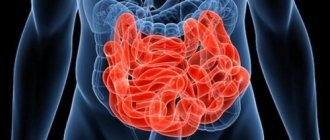Published 03/05/2019 · Comments: · Reading time: 6 min · Views: Post Views: 880
Almost every person, especially those far from medicine, considers constipation only an inconvenient and annoying problem, but not a disease. However, constipation is not just retention of stool, it is evidence of ill health, which is increasingly common among the inhabitants of modern society, a kind of retribution for physical inactivity and poor nutrition. But what’s most unpleasant is that this condition can be the first sign, a warning sign of serious and even life-threatening diseases.
Causes
First of all, you need to establish the causes of spastic constipation in order to choose the best treatment method. Therefore, if the first signs of digestive problems appear, it is better to consult a specialist.
So, the main causes of spastic constipation include the following:
- Quite often, spastic constipation appears after nervous shock, stress or overwork. Any stressful or conflict situation negatively affects the functioning of the gastrointestinal tract.
- Poor nutrition, including frequent snacking on sandwiches and fast foods.
- A sedentary lifestyle also negatively affects the functioning of the stomach.
- Violation of water-salt balance in the body.
- Bad habits, such as smoking.
- Artificial delay of the natural urge to defecate.
- Health problems such as pituitary gland diseases, intestinal obstruction, diabetes, hormonal disorders.
Methods for treating constipation
In most cases, diet and special exercises help overcome atonic constipation. Treatment necessarily involves nutritional correction. The patient should include foods rich in fiber in his daily diet: pumpkin, carrots, prunes, beets. It is useful to eat buckwheat and oatmeal. In this case, vegetables and fish should be taken boiled. Eating must take place according to schedule.
As for physical activity, it is an integral part of the treatment of constipation. Doctors have developed a set of special exercises that help strengthen the abdominal muscles. To eliminate constipation in children, therapeutic abdominal massage is recommended.
If the described methods do not eliminate atonic constipation, therapy is supplemented with laxatives.
Diagnostics
When the first symptoms of spastic constipation appear, it is recommended to consult a doctor who will examine the patient by intestinal palpation. In this case, the rectum will be relaxed and dilated, and the intestinal muscles will be tense. Only a qualified specialist can determine the type of constipation and the causes of its occurrence.
In some cases, additional research may be required. Thus, ultrasound of internal organs, fibrocolonoscopy, irrigoscopy or sigmoidoscopy are prescribed. Stool samples must be taken. All these methods allow you to assess the condition of the intestinal cavity.
What is atonic constipation?
Constipation in adults occurs due to improper functioning of the muscles of the large intestine.
Normally, a healthy person should have a bowel movement every day. If this does not happen within 48 hours, the condition is called constipation. There are atonic and spastic constipation. The latter are characterized by defecation of a small amount of feces, increased gas formation, and pain in the lower abdomen. The patient feels sluggish. During the examination, a slowdown in stool movement is detected.
With atonic constipation, defecation occurs in large masses, as a result of which ruptures of the mucous membrane often occur. For this reason, the stool may be mixed with blood. In this case, defecation is very difficult and painful.
Atonic constipation usually occurs in overweight people who exercise little. The fact is that with weak intestinal muscles, feces move slowly, which leads to their accumulation in large quantities. A full intestine puts pressure on nearby organs, causing pain in the lower abdomen.
Symptoms
Next, we will consider the main symptoms of spastic constipation, when they appear, it is recommended to consult a doctor in order to avoid serious illnesses in the future:
- If there is no natural bowel movement for two days. This indicates the presence of atonic and spastic constipation.
- The appearance of discomfort during an attempt to have a natural bowel movement. Tension of the abdominal muscles is also observed.
- There is a feeling of a full stomach.
- Increase in abdominal volume and feeling of fullness.
- Abdominal pain and nausea.
- Deterioration of general condition, headache, irritability and fatigue.
Symptoms of constipation
Spastic constipation is characterized by irregular defecation delays. During disruption of the colon, both normal bowel movements and loose stools are observed. To determine the type of stool retention, you need to know its signs. It should be remembered that daily bowel movements are not necessary. A one-day absence of bowel movements is not a sign of tract obstruction. The main symptom of spastic constipation is regular cramping pain in the lower abdomen, predominantly of a spasmodic nature. Other characteristic symptoms indicating spastic constipation include:
- Flatulence and bloating.
- Belching.
- Unpleasant taste in the mouth.
- Loss of appetite.
- Weakness of the body and rapid fatigue.
- Insomnia.
- Pallor of the skin, loss of elasticity.
Symptoms of childhood stool retention are specific. Babies scream in pain, cry, tuck their legs, behave capriciously and restlessly. Coprostasis is manifested by significant frequency of defecation for up to 36 hours, pain and colic in the abdomen, and tension during bowel movements. With constipation in infants, the stool becomes hard.
Pregnant women experience problems with bowel movements in the early stages. The main reason for difficult bowel movements is discomfort in the abdomen, a feeling of incomplete emptying of the intestines, and a quantitative decrease in stool. For many women, problems persist throughout pregnancy.
Treatment methods
Comprehensive treatment of spastic constipation is prescribed in order to obtain the highest quality and fastest results. The most important thing is to establish the cause of the problem in order to choose an effective treatment method. In most cases, the doctor prescribes a diet aimed at restoring the natural processes of defecation, medications and folk recipes to liquefy stagnant feces and remove them from the body naturally.
Diet
For spastic constipation, a special diet is developed aimed at restoring normal activity of the gastrointestinal tract.
You must adhere to the following simple recommendations:
- It is best to eat dishes in the form of porridges or purees. In other words, any product must be crushed to a homogeneous mass.
- Next, you need to exclude products containing binders from the menu. This includes strong tea, rice, jelly, and potatoes.
- Meals should be warm to reduce intestinal spasms.
- It is also necessary to eliminate increased gas formation by eliminating legumes and cabbage from the diet.
- To avoid irritation of the delicate intestinal mucosa, it is not recommended to consume spices, onions and garlic.
- It is worth reducing portions and increasing the number of meals. This will allow your intestines to fill evenly throughout the day.
- You can eat soups based on boiled vegetables with the addition of butter.
- Boiled fish and lean meat are also acceptable.
- We prepare porridge with milk or water.
- Grind the fruits to a puree, except blueberries and citrus fruits.
- Healthy fresh fermented milk products, weak teas and compotes.
- It is worth including in your daily diet foods containing large amounts of vitamin B1, which can have a positive effect on the nervous system.
Symptoms of spastic constipation
Constipation caused by spasm of the intestinal wall has special, rather unpleasant manifestations that cause not only inconvenience in everyday life, but also disturbances in well-being and pain.
- Spasms. Often accompanied by a feeling of painful pressure in the abdomen, nagging or even sharp pain, tension.
- Bloating. The release of gases is facilitated by defecation, accompanied by the so-called “sheep” stool - in the form of hard lumps, of such a consistency that they can even injure the mucous membrane.
- Stool retention - up to 3 - 4 days.
- Mucus in the stool, up to the discharge of thick lumps instead of stool.
- Mental disorders - fatigue, nervousness, irritability, lack of appetite.
- When palpating the abdominal wall, you can palpate tension in the area of the sigmoid colon.
Features of treatment
The symptoms and treatment of spastic constipation may vary depending on the condition of the individual patient. Therefore, only a doctor can prescribe the correct treatment, using both medications and traditional recipes. The main thing is that the treatment is comprehensive, which will help quickly restore normal functioning of the digestive system.
In children
Quite often, when switching to a non-adult diet, problems arise in children from the gastrointestinal tract. Reasons include low fluid intake and large amounts of sweet foods. As a result of emotional shock, the baby may experience a spasm of the smooth muscles of the intestines.
If a child has spastic constipation, he is prescribed medications that simultaneously relieve spasms and accelerate the natural processes of defecation. These are mainly candles that have a relaxing and laxative effect.
In older people
In older people, the causes of constipation are more serious, so it is always recommended to consult a doctor. In addition to poor nutrition, problems with the endocrine and nervous system can lead to intestinal spasms. That is why treatment should be carried out under the supervision of a doctor.
In pregnant women
Almost every second pregnant woman experiences problems with the digestive system. Thus, both constipation and diarrhea may occur due to the formation of a new organism. The uterus increases in size every day, which negatively affects the intestinal muscle tissue. This is why spastic constipation is possible. But after childbirth, normal functioning of the gastrointestinal tract should be restored. Treatment should only be prescribed by a specialist.
Treatment measures
Treatment depends on the type of constipation and the cause of the abnormality. The therapeutic course is selected by the doctor after receiving the diagnostic results. The patient is first given a referral to:
- examination of the internal intestinal cavity;
- rectal examination;
- radiography.
Additional symptoms may be prescribed depending on the clinical picture. That is, the treatment of spastic and atonic constipation is complex.
Read also: quick-acting remedies for urgent relief of constipation.
Treatment of constipation consists of changing the diet, taking medications and using traditional methods. The patient must carefully follow all the doctor's recommendations.
People suffering from constipation may benefit from eating more vegetables.
Nutritional Features
Diet for constipation is the first thing you need to resort to if you want to eliminate the problem. It is required to give preference to foods of plant origin. Food should have a uniform consistency. The products are first ground using a blender.
Sugar is replaced with honey. Treatment of spastic constipation is characterized by the need to consume sufficient amounts of fat. You are allowed to drink homemade juices, compotes, herbal teas and still mineral water.
It is necessary to completely exclude from the diet:
- fatty foods;
- food that has a low temperature;
- baking;
- sausages;
Sweets and baked goods should be completely avoided
- various preserves and marinades;
- spicy foods and foods with a lot of seasonings;
- rice porridge;
- confectionery;
- mushrooms;
- alcoholic drinks;
- salty snacks;
- cocoa.
The diet must include liquid foods at least once a day. The diet for the spastic type of pathology or atonic constipation is no different. It is important to exclude all harmful foods.
This video will help you normalize your stool:
Drug treatment
To treat atonic and spastic constipation, the patient is prescribed the following laxative medications:
- osmotic drugs;
- medications that stimulate the functioning of the intestines, irritating effects;
- lubricating drugs.
In addition, the patient is recommended to take probiotics and prokinetics. Medicines help restore intestinal motility and restore the natural microflora of the body. Food begins to be digested normally. The condition of the gastrointestinal mucosa is normalized.
Probiotics can help relieve constipation
In the treatment of atonic and spastic constipation, choleretic drugs are recommended. Thanks to this, the process of digesting food improves. The content moves smoothly to the output.
In the atonic form of constipation, the patient is advised to take hemostatic drugs. Medicines are necessary if there is blood in the feces.
Traditional methods of treatment
Complex treatment of atonic and spastic constipation includes the use of traditional therapeutic methods. Plantain seeds are highly effective. They are first crushed and consumed 1 tbsp. l. before bedtime.
An effective folk method - vegetable oil on an empty stomach
After waking up, it is recommended to drink a tablespoon of vegetable oil. The component is washed down with a glass of water. This must be done on an empty stomach. Positive dynamics will appear after a few hours.
Prunes are highly effective. 2 tbsp. l. dried plums are poured with 250 ml of boiling water. Infuse the drink for two hours. Drink 125 ml twice a day.
Before using any traditional methods, you should consult a doctor. Otherwise, there is a high risk of an allergic reaction.
Reasons for appearance
Most people who are faced with a disease such as constipation incorrectly assess all the symptoms and, as a result, misinterpret the cause. Then they take the wrong medications, thereby harming the body.
However, spastic constipation occurs due to a number of physical, mental and emotional reasons:
- wrong diets;
- incorrect diet;
- nervous breakdowns;
- smoking;
- sedentary lifestyle;
- snacks;
- suppression of the desire to have a bowel movement;
- endocrine disruptions;
- insufficient water consumption.
It is worth recalling that this disease is often accompanied by flatulence and bloating, which is directly related to the occurrence of unreasonable gases and constipation.
In children and infants
Spastic conditions in children are a common occurrence in preschool and school age. It occurs as a result of poor nutrition - excessive consumption of sweets, a quick dry snack, for example, at school during breaks, or as a result of prolonged stress.
Spasms in the intestines of infants appear due to an incompletely formed nervous system and a transition to artificial feeding, which ultimately causes neurogenic constipation.
Treatment of childhood spastic constipation is carried out by a doctor. Basically, it all comes down to a short course of treatment with rectal suppositories; in very rare cases, antispasmodics are prescribed.
Prevention of this disease
To prevent the possibility of spastic constipation, it is necessary to follow preventive measures.
- If a person is prone to intestinal stagnation, he needs to reduce the consumption of foods that cause problems with bowel movements. What products are we talking about? These are lard, meat, cakes, eggs, chocolate, flour products, white flour, cocoa, etc.
- To reduce the risk of this disease to a minimum, it is recommended to eat food with coarse indigestible fibers daily. These are vegetables, fruits and grains.
- People prone to cramps should avoid eating cold foods. First of all, you need to give up ice cream.
- Overeating can cause intestinal spasms. Therefore, in order to prevent its occurrence, you need to get up from the table before you feel completely full. Water fasting, alternating with fasting days, not only prevents spastic constipation, it also brings great health benefits.
- You should not eat spoiled or stale food.
- You should always empty your bowels on time. The urge to defecate cannot be ignored.
Characteristics of the pathology
In gastroenterology, there are two types of constipation: spastic and atonic.
Atonic constipation occurs in cases where the influence of the nervous system on the intestinal walls is disrupted . Muscle relaxation occurs, peristalsis decreases, and the intestinal lumen increases, which makes it difficult to remove feces.
Spastic constipation occurs in cases where there is spasm of smooth muscles . In this case, the intestinal lumen decreases and an obstacle to the movement of feces is created.
Constipation is a buildup of stool in the intestines
The difference between these two types of difficult bowel movements is as follows:
- With atony, the intestinal wall relaxes, and with spasticity, tension occurs. Therefore, the second type of constipation is accompanied by severe spasmodic pain in the abdomen.
- Spastic constipation is usually a short-term phenomenon. It occurs after nervous overstrain, in emotionally labile people. Atonic constipation has a chronic course. In this case, the difficulty of emptying continues for a long time. The formation of dense stool usually occurs over a period of six months or more.
Causes of pathology
The causes of problems with stool can be divided into the following groups:
- Wrong lifestyle:
- passion for refined products, depleted in dietary fiber and plant fiber;
- low fluid intake;
- unbalanced food intake;
- physical inactivity (lack of motor activity);
- frequent restraint of bowel movements associated with professional characteristics.
- Neurological problems:
- disruption of the nervous regulation of the intestinal wall (Hirschsprung's disease);
- multiple sclerosis;
- neurasthenic state;
- suffered a stroke;
- spinal or brain tumors;
- mental illness.
- Endocrine reasons:
- hypothyroidism;
- obesity;
- diabetes;
- menopause;
- decrease in calcium levels in the blood.
- Digestive diseases:
- irritable bowel syndrome;
- pancreatitis;
- peptic ulcer,
- inflammation of the small and large intestines;
- tumors;
- hemorrhoids and anal fissures;
- gastritis with reduced secretion of hydrochloric acid;
- intestinal dysbiosis.
- Temporary reasons:
- pregnancy;
- change of place of residence (“travelers’ constipation”);
- lead and mercury poisoning;
- eating foods that thicken stool;
- stress;
- taking certain medications;
- long bed rest.
How to get rid of constipation - video
https://youtu.be/m-u3nZ04WjE
Prevention
Prevention of this pathological process consists of the following recommendations:
- elimination of stress, severe nervous tension;
- a properly balanced diet and eating in a leisurely environment;
- timely treatment of all gastroenterological diseases;
- taking only those medications prescribed by the doctor;
- including a sufficient amount of physical activity in your daily routine.
In addition, you should regularly visit a gastroenterologist for preventive purposes and not self-medicate.
Types of constipation
There are several classifications of this disease that help to better understand the cause of the problem and the differences in the symptoms of constipation.
They are divided into acute and chronic. Acute constipation is said to occur when there is no bowel movement for several days. Usually the acute process is associated with cancer of the colon and the use of certain medications. Chronic constipation is digestive problems that last for at least six months. An acute process always has a more pronounced clinical picture and painful symptoms.
The following classification is based on the causative factors that contribute to the development of constipation:
- Alimentary – constipation, which develops against the background of a violation of the diet and incorrect preparation of the menu. A lack of fluid, fiber, dietary fiber and fermented milk products can lead to hardening of stool and constipation.
- Hypodynamic. This type is caused by a lack of physical activity. It is especially common among the elderly, pregnant women, etc.
- Medication. A number of medications can cause constipation. Such drugs include laxatives, antispasmodics, sedatives, tranquilizers, etc.
- Mechanical. Obstacles to the passage of feces can be rectal polyps, pathologically enlarged hemorrhoids, neoplasms, accumulation of parasites (roundworms), and hypertrophied prostate in men.
- Neurogenic. The impact of psychological factors on defecation disorders, fear of pain due to hemorrhoids, anal fissure, paraproctitis, when a person independently suppresses bowel movements.
- Proctogenic. This type involves a violation of the movement of feces due to diseases of the rectum. This includes pathologies such as hemorrhoids, anal fissures, proctitis, colitis, etc.
- Endocrine. Dysfunction of the endocrine glands can also lead to constipation, as a number of hormones control intestinal motility. In this regard, thyroid pathologies or diabetes mellitus may be accompanied by constipation.
Constipation is divided into spastic and atonic. This division reflects the pathogenetic differences and differences in symptoms between these two types of constipation. Each of them requires different treatment, which necessitates such a classification.











